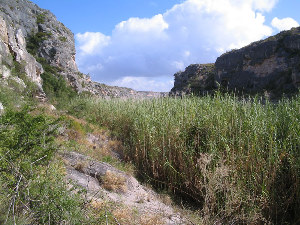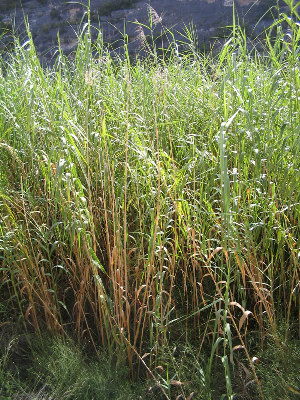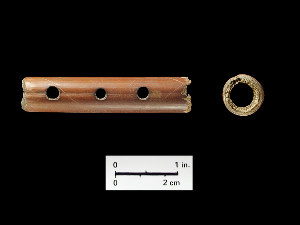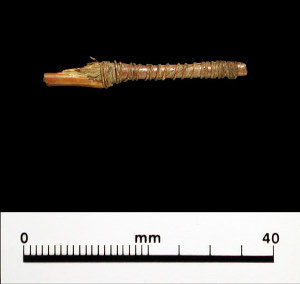Common Reed
Phragmites australis (Cav.) Trin ex. Steud.
(synonyms: Arundo phragmites, Phragmites communis)
Poaceae (Grass Family)
This cane-like grass grows to a height of 12 feet or more in dense stands along creek and river banks. Native peoples used common reed in many different ways. They made musical instruments, weapons, and containers from it as well as using it for food, medicine, and games.
Common reed spreads by thick rhizomes and stolons. It closely resembles the giant cane (Arundo donax), an invasive species, but common cane stems have a smaller diameter and the "joints" or nodes are spaced more closely, making internodes or segments shorter. The panicles or seed heads of common reed spread laterally and are less dense than those of giant cane.
Archeological occurrence. Common reed was utilized for a variety of food and technological purposes. Artifacts made of common reed in the collections from the Pecos River region include reed flutes from the Perry Calk site (41VV87) and a cane tube (sucking tube or smoking tube from 41VV161). A specimen from Centipede Cave (AMIS 25201) is decorated with a snake-like, serpentine line burned into it. Another specimen of unknown function from Centipede Cave is wrapped with fine cordage. Finally, Shumla Cave 5 yielded a cane cigarette stuffed with juniper leaves.
Food. Indians in certain areas of western North America harvested the sweet exudate, called honey dew, from several different plants. The Koso cut the reeds of Phragmites australis, dried it, and pounded the whole plant and sifted gum from it (Heizer 1945:140). The Paiute cut the reeds and dried them in piles on blankets or hides for a short time. Then they beat the reeds with rods, releasing the gummy exudate. The Gosiute, Owens Valley Paiute, Humboldt Lake Paviotso, and others collected common reed in a similar matter, some using cattail mats instead of hides (Heizer 1945:143). Most references note that the tiny particles were collected into large balls of sugar, and these were sometimes baked until brown. Palmer (1871:423) records the use of sugar derived from cane by the Paiute (reported as Arundo phragmites).
This sugar was aptly coined "bug sugar" by Harrington (1944), for it is actually secreted by aphids grazing on the cane. Volney Jones (1945:145) quoted an early Mission record by Pere Picolo in southern California:
"In the months of April, May and June there falls with the dew a kind of manna, which solidifies and hardens on the leaves of reeds from which it is collected. I have tasted some. It is a little less white than sugar, but has all the sweetness of it."
The sugar was actually produced by aphids that spend the winter on wild relatives of the plum or cherry (Prunus spp.) and the summer on common cane (Jones 1945:147). This practice of harvesting the sweet exudate deposited on the leaves of common reed and other plants seems to have been limited to the geographic regions of Nevada, Utah, and northern Arizona along the lower Colorado River, with some indication of use on the California coast. It may however, have been utilized by groups elsewhere who dropped the practice shortly after contact with Europeans (or who did not survive). Hodgson (2001:68-70) relates a detailed account of historical references to the use of honey-dew.
Medicine. The White Mountain Apache used the root of common cane to treat stomach ailment and diarrhea (Reagan 1928:159). The Cahuilla used the cane for splints to treat broken bones (Bean and Saubel 1972:102).
Construction, weaving, containers. The Hopi used common reed for roofing material (Whiting 1939). The Seri used the cane for sea-going canoe construction. The canoes were composed of three large reed bundles that were tied together using mesquite root cordage to make a canoe that was about 16 feet-long (Felger and Moser 1985:131; 310-311). Baja California inhabitants utilized common cane for weaving, roofing, and doors (Vasey and Rose 1890). The Pima used cane to construct mats (Curtin 1949:75). The Havasupai used cane mats as platforms for drying yucca fruit pulp (Weber and Seaman 1985:209).
The Seri used segments of common reed to store cattail pollen for face paint, powdered ochre, and creosote bush. A wooden stopper was placed in one end (Felger and Moser 1985:311).
Weapons. Many groups constructed arrows from the light weight and durable common cane. The Cahuilla inserted a foreshaft of mesquite or greasewood into the common cane shaft (Bean and Saubel 1972:102). Several other groups constructed arrow shafts from common cane, including the Havasupai, Kawaiisu, Navajo, Northern Paiute, and Tewa (Elmore 1944::26; Fowler 1990:75; Robbins et al. 1916; Weber and Seaman 1985:209; Zigmond 1981:49). The White Mountain Apache made an arrow shaft from common reed specifically for hunting birds (Reagan 1928:159).
Games, ceremony, music, and smoking. The utilization of plants in these categories is often intertwined, for gaming, ceremony, music and smoking are often part of or related to ceremony. The Seri used painted game sticks fashioned from carved reed segments and painted with stripes. They were used like dice. Another game was played with four reed segments filled with sand, and one of the four contained a red coral bean. The men would pour the sand out of each tube and guess which one contained the coral bean (Felger and Moser 1985:132). The Tewa made gaming sticks from the cane (Robbins et al. 1916:66). The Navajo constructed prayer sticks from cane (Elmore 1944:26).
Several musical instruments were constructed from common reed by the Seri, including the mouth bow, split reed rattles, and shaman's flute (Felger and Moser 1985:170). The Cahuilla also constructed flutes out of reed (Bean and Saubel 1972:102). Curtin (1949:75) reported that the Pima made flutes from the common cane, which was quickly disappearing during the first half of the 20th century due to subsurface wells in the region.
Many groups used common cane for either pipe stems or cane cigarettes. Several lower Yuman groups of Arizona and California utilized the cane tubes in a similar manner (Castetter and Bell 1951:122). The Seri smoked several plants, including ragweed (Ambrosia ambrosioides), creosote bush (Larrea tridentata), a native Ruellia, and two native species of Nicotiana (Felger and Moser 1985:165). This suite of smoking plants is mentioned because the material found in the cane smoking tubes of the Lower Pecos area is juniper (cedar). The Seri would smoke using a piece of cane a pipe made of fired clay or stone. The Papago preferred to smoke tobacco in a cane tube, about six inches long (Castetter and Underhill 1935:27). The Havasupai and the Kawaiisu used cane to construct pipe stems (Weber and Seaman 1985:209; Zigmond 1981:49). The White Mountain apache used the reed as a cigarette, filling it with tobacco and igniting it, then puffing the smoke to each of the sacred regions or directions, which are not specified by the recorder (Reagan 1928:159).
References:
Bean, Lowell J. and Katherine S. Saubel
1972 Temalpakh: Cahuilla Indian Knowledge and Usage of Plants. Malki Museum Press, Morongo Indian Reservation, Banning, California.
Castetter, Edward F. and Ruth Underhill
1935 The Ethnobiology of the Papago Indians. Ethnobiological Studies in the American Southwest. Vol. II. The University of New Mexico Bulletin, Biological Series 4(3), Albuquerque.
Castetter, Edward F. and Willis Bell
1951 Yuman Indian Agriculture. University of New Mexico Press, Albuquerque.
Castetter, Edward F. and Ruth Underhill
1935 The Ethnobiology of the Papago Indians. Ethnobiological Studies in the American Southwest, Vol. II. The University of New Mexico Bulletin, Biological Series 4(3), Albuquerque.
Curtin Leonora Scott Muse
1949 By the Prophet of the Earth: Ethnobotany of the Pima. 1984 reprint. University of Arizona Press, Tucson, Arizona.
Felger, Richard and Mary Moser
1985 People of the Desert and Sea: Ethnobotany of the Seri Indians.
University of Arizona Press, Tucson.
Fowler, Catherine S.
1990 Tule Technology: Northern Paiute Uses of Marsh Resources in Western Nevada. Smithsonian Institution Press, Washington, D.C.
Harrington, M. R.
1945 Bug Sugar. The Masterkey 19(3):95-96.
Heizer, Robert F.
1945 Honey-Dew "Sugar" In Western North America. The Masterkey 19(5):140-145.
Hodgson, Wendy
2001 Food Plants of the Sonoran Desert. University of Arizona Press, Tucson, Arizona.
Jones, Volney
1945 The Use of Honey-Dew as Food by Indians. The Masterkey 19(5):145- 153.
Palmer, Edward
1871 Food Plants of the North American Indians. USDA Report to the Commissioner of Agriculture for 1870, pp. 404-428. U.S. Government Printing Office, Washington, D.C.
Reagan, Albert D.
1928 Plants Used by the White Mountain Apache Indians of Arizona. The Wisconsin Archeologist 8:143-161.
Robbins, Wilfred Wiliam, John Peabody Harrington, and Barbara Freire-Marreco
1916 Ethnobotany of the Tewa Indians. Bureau of American Ethnology Bulletin 55. Smithsonian Institution. Washington, D.C.
Vasey, George and J. Rose
1890 List of Plants Collected by Dr. Edward Palmer in Lower California in 1889: Plants Collected Near the Head of the Gulf of Lower California. Contributions from the U.S. National Herbarium 1(1):27-28.
Weber, Steven A. and P. David Seaman
1985 Havasupai Habitat: A.F. Whiting's Ethnography of a Traditional Indian Culture. University of Arizona Press, Tucson.
Whiting, Alfred
1939 Ethnobotany of the Hopi. Museum of Northern Arizona Bulletin No. 15, Flagstaff.
Zigmond, Maurice L.
1981 Kawaiisu Ethnobotany. University of Utah Press, Salt Lake City.
![]()





